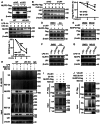UFMylation of NLRP3 Prevents Its Autophagic Degradation and Facilitates Inflammasome Activation
- PMID: 39985286
- PMCID: PMC12005806
- DOI: 10.1002/advs.202406786
UFMylation of NLRP3 Prevents Its Autophagic Degradation and Facilitates Inflammasome Activation
Abstract
NLRP3 (NOD, LRR and pyrin domain-containing protein 3) inflammasome is important for host defense against infections and maintaining homeostasis. Aberrant activation of NLRP3 inflammasome is closely related to various inflammatory diseases. Post-translational modifications are critical for NLRP3 inflammasome regulation. However, the mechanism of NLRP3 inflammasome activation remains incompletely understood. Here, it is demonstrated that the Ufm1 E3 ligase Ufl1 mediated UFMylation is essential for NLRP3 inflammasome activation. Mechanistically, Ufl1 binds and UFMylates NLRP3 in the priming stage of NLRP3 activation, thereby sustaining the stability of NLRP3 by preventing NLRP3 K63-linked ubiquitination and the subsequent autophagic degradation. It is further demonstrated that myeloid cell-specific Ufl1 or Ufm1 deficiency in mice significantly alleviated inflammatory responses and tissue damage following lipopolysaccharide (LPS)-induced endotoxemia and alum-induced peritonitis. Thus, the findings offer new insights into potential therapeutic targets for NLRP3 inflammasome-related diseases by targeting the UFMylation system.
Keywords: NLRP3 inflammasome; UFMylation; autophagic degradation; therapeutic target.
© 2025 The Author(s). Advanced Science published by Wiley‐VCH GmbH.
Conflict of interest statement
The authors declare no conflict of interest.
Figures






References
MeSH terms
Substances
Grants and funding
LinkOut - more resources
Full Text Sources
